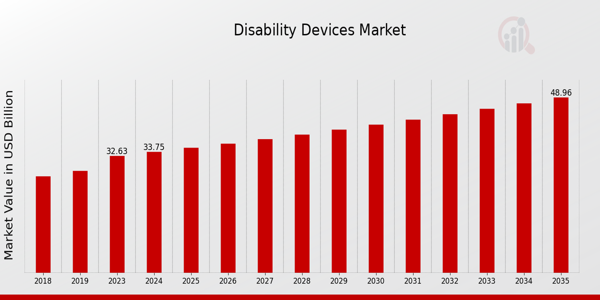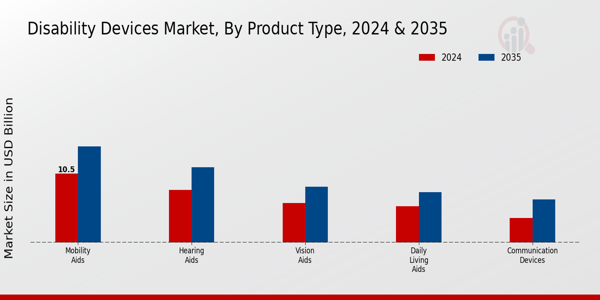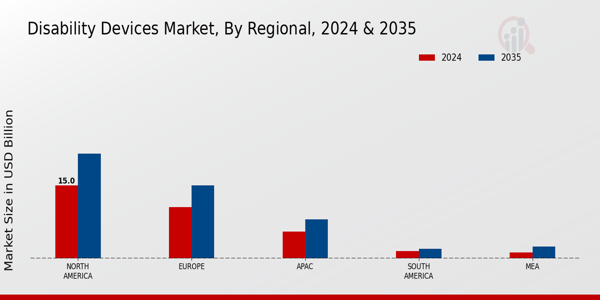Disability Devices Market Overview
As per MRFR analysis, the Disability Devices Market Size was estimated at 32.63 (USD Billion) in 2023. The Disability Devices Market Industry is expected to grow from 33.75 (USD Billion) in 2024 to 49.0 (USD Billion) by 2035. The Disability Devices Market CAGR (growth rate) is expected to be around 3.44% during the forecast period (2025 - 2035).
Key Disability Devices Market Trends Highlighted
The Global Disability Devices Market is witnessing significant growth driven by key market drivers such as an aging population, increasing prevalence of disabilities, and greater awareness about accessibility. Innovations in technology, like smart devices and assistive technologies, are enhancing the functionality and appeal of disability aids. This growth is also supported by government initiatives aimed at improving access to healthcare and promoting the rights of individuals with disabilities. As healthcare evolves, there is a stronger demand for customized solutions that cater to individual needs, making it crucial for market players to adapt and innovate continuously.Opportunities to be explored include the growing demand for personalized devices that offer better comfort and usability. Emerging markets present a significant chance for businesses as they expand their reach into regions where the availability of disability devices is limited.
Collaborations between technology companies and healthcare providers can lead to the creation of smarter, more integrated solutions that address a variety of needs. The rise of telehealth also offers a platform for accessibility in remote areas, indicative of a shift toward service-oriented models that enhance customer experience. Trends in recent times show a marked increase in the demand for digital solutions that complement traditional devices.Wearable technology is gaining traction, allowing users to monitor their health and mobility while maintaining independence. Furthermore, the rising focus on inclusivity is influencing product design, prompting companies to prioritize user-centered approaches. Overall, the Global Disability Devices Market reflects a dynamic landscape that is adapting to changing societal needs and technological advancements, creating a fertile ground for future growth and innovation.

Source: Primary Research, Secondary Research, MRFR Database and Analyst Review
Disability Devices Market Drivers
Rising Aging Population
The Global Disability Devices Market is rising at a considerable pace due to the growing aging world population. Settlement systems are being converted such that devices and mechanisms are set in place at various locations where the elderly or disabled would be able to get assistance. With the aid of advanced technology and devices, elderly people are given means with which they can become self-sufficient and conduct daily activities without reliance on those caring for them.
The demand for Wheelchairs, hearing aids and personal mobility aid devices is on the rise, which is why there is now a great focus on technologically advancing these devices for the elderly. This aids their mobility and also improves their quality of life. Moreover, investing in such devices will enable elderly people to receive quality care and enable healthcare policymakers to aid their patients with support.
The expansion of the Global Disability Devices Market Industry is aided by an increase in geriatric care services and improved healthcare facilities. Manufacturers are increasingly focusing more on product development and new technologies due to the projected increase in older populations that require advanced assistive devices. Newer technologies in manufacturing and the addition of smart functions in disability devices also address the needs of elderly users and provide better-tailored, more efficient solutions.
Technological Advancements
Technological advancements are a major driver propelling the Global Disability Devices Market Industry forward. Innovations in materials, design, and digital technology have significantly transformed the landscape of assistive devices, making them more effective and user-friendly. The integration of smart technology into disability devices, such as intelligent wheelchairs and hearing aids with smartphone connectivity, has dramatically improved their functionality.These advancements not only enhance the performance of devices but also contribute to the user experience, providing individuals with a greater sense of control and independence. As technology continues to evolve, manufacturers are likely to invest heavily in research and development to create cutting-edge products that align with the needs of consumers in the Global Disability Devices Market Industry.
Increased Awareness and Advocacy
Increased awareness and advocacy for disability rights have emerged as crucial factors driving growth in the Global Disability Devices Market Industry. Social movements and campaigns aimed at promoting inclusivity and accessibility for individuals with disabilities have gained traction, leading to heightened visibility of the challenges faced by this demographic. As a result, there is a growing demand for disability devices that enable individuals to participate more fully in society, pursue education, and gain employment.Advocacy groups and organizations are actively pushing for policies that support the availability and affordability of assistive technologies, thereby facilitating better access to necessary devices. This shift not only informs public perception but also influences government funding and insurance coverage for disability devices, making it an essential market driver for the future.
Disability Devices Market Segment Insights
Disability Devices Market Product Type Insights
The Global Disability Devices Market is set to witness significant revenue growth, with the overall market anticipated to be valued at 33.75 USD Billion in 2024. This market is segmented into various product types, which play crucial roles in enhancing the quality of life for individuals with disabilities. Mobility Aids is a prominent category, valued at 10.5 USD Billion in 2024 and projected to reach 14.7 USD Billion by 2035, highlighting its majority holding in the market due to the essential nature of mobility solutions for the disabled. Hearing Aids follows as another significant segment, with a valuation of 8.0 USD Billion in 2024 and expected to grow to 11.5 USD Billion by 2035. The demand for hearing aids is largely driven by the increasing prevalence of hearing impairments, making it a critical component in maintaining communication and social integration for affected individuals. Vision Aids, valued at 6.0 USD Billion in 2024 and anticipated to grow to 8.5 USD Billion by 2035, also plays a vital role, particularly in enabling visually impaired individuals to navigate their surroundings and engage in daily activities, thus offering considerable market significance.
Daily Living Aids represents another essential segment, initially valued at 5.5 USD Billion in 2024 and projected to grow to 7.7 USD Billion by 2035. This category is important as it encompasses a wide range of products that aid individuals in performing essential daily tasks, contributing significantly to their independence and improving their overall quality of life. Finally, Communication Devices hold a valuation of 3.75 USD Billion in 2024, expected to rise to 6.6 USD Billion by 2035. Though smaller in comparison to the other segments, this category is vital for individuals with speech impairments, as it enables effective communication. The collective growth across these product types showcases a broader trend of increased awareness and technological advancements aimed at supporting individuals with disabilities. The growth in the Global Disability Devices Market is fueled by several factors, including an aging population, increased incidence of disabilities, and rising government initiatives to promote accessibility and inclusion.
However, challenges such as high costs and limited insurance coverage can hinder market growth. Nevertheless, the opportunities presented by innovations in technology, such as smart devices and improved materials, are likely to further enhance the market potential. The comprehensive data surrounding these segments not only reflects the current landscape of the Global Disability Devices Market but also indicates a future of growth and evolving needs driven by advancements and societal change. With the market statistics reflecting a steady rise, particularly in the prominent product categories, the importance of these devices in transforming the lives of individuals with disabilities is undeniable, signaling a positive trajectory for the industry.

Source: Primary Research, Secondary Research, MRFR Database and Analyst Review
Disability Devices Market End User Insights
The Global Disability Devices Market is projected to experience robust growth driven by diverse end users, including the elderly, physically challenged individuals, the visually impaired, and the hearing impaired. By 2024, the overall market will be valued at 33.75 USD Billion, reflecting the increasing demand for assistive technologies that enhance mobility, independence, and quality of life. The elderly population represents a significant share of this market, as their healthcare needs drive innovation in devices that aid daily activities. Similarly, the physically challenged segment is crucial, as these individuals require specialized solutions that promote inclusivity and accessibility.The visually impaired and hearing impaired are also key end users, with a substantial demand for devices that improve communication and navigation.
This growing awareness of the need for personalized disability aids underpins the importance of tailored solutions in the Global Disability Devices Market revenue, showcasing a clear trend toward customization and technological advancement across various demographics. As the market evolves, these end user categories will play pivotal roles in shaping product offerings and influencing market growth strategies, highlighting the importance of understanding their specific needs and preferences.
Disability Devices Market Distribution Channel Insights
The Global Disability Devices Market is projected to achieve a valuation of 33.75 billion USD by 2024, showcasing a notable trend in the evolution of distribution channels. Within this context, various channels, such as online stores, retail pharmacies, specialty stores, and hospitals, play a significant role in the distribution landscape. The online stores segment has seen a substantial increase in adoption, driven by consumer preferences for convenience and accessibility, ultimately transforming the purchasing experience. Retail pharmacies dominate the market by providing essential support and consultation services, making them a vital point for customers.Specialty stores cater to specific needs with a focused product range, which attracts customers seeking specialized products.
Hospitals serve as crucial distribution channels by integrating device procurement into patient care protocols, ensuring that quality products are readily available for patients' needs. Overall, the Global Disability Devices Market statistics highlight the importance of these distribution channels in enhancing market accessibility, addressing varied consumer needs, and fostering significant growth within the industry.
Disability Devices Market Material Insights
The Global Disability Devices Market, forecasted to be valued at 33.75 billion USD in 2024, presents a diverse array of materials that contribute significantly to its overall growth and segmentation. Among these materials, Plastic plays a vital role due to its lightweight, durability, and versatility, often being the preferred choice for a variety of mobility devices and daily living aids. Metal, known for its strength and longevity, frequently dominates the market for heavy-duty devices such as wheelchairs and walkers, providing essential support and stability.Wood, while less common in modern manufacturing, retains importance in assistive devices like canes and furniture, valued for its natural appeal and ability to provide comfort.
Fabric contributes substantially in terms of upholstery for seating and support items, enhancing user comfort and preference. The ongoing trends in the Global Disability Devices Market illustrate a rising demand for innovative material solutions that cater to various disabilities, propelled by advancements in technology and an aging population. The market growth is supported by an increasing emphasis on accessibility and rehabilitation, presenting ample opportunities for development and innovation across all material categories.
Disability Devices Market Regional Insights
The Regional segment of the Global Disability Devices Market is characterized by diverse growth dynamics, with North America leading the valuation landscape at 15.0 USD Billion in 2024, expected to rise to 21.5 USD Billion by 2035, demonstrating its majority holding in the industry. Europe follows, valued at 10.5 USD Billion in 2024 and projected to reach 15.0 USD Billion, reflecting significant demand due to an aging population and increasing awareness about disability aids. Meanwhile, APAC is valued at 5.5 USD Billion in 2024 and is estimated to grow to 8.0 USD Billion, showcasing its emerging potential driven by socioeconomic improvements and enhanced healthcare access.South America presents a smaller market at 1.5 USD Billion in 2024, increasing to 2.0 USD Billion, indicating gradual growth influenced by local healthcare reforms. Lastly, the MEA region holds a valuation of 1.25 USD Billion in 2024, potentially growing to 2.5 USD Billion, underlining its relatively nascent stage in the market. Overall, the Global Disability Devices Market segmentation illustrates varied growth opportunities influenced by regional health policies, demographics, and societal attitudes toward disability aids, shaping the path for sustained market growth in the coming years.

Source: Primary Research, Secondary Research, MRFR Database and Analyst Review
Disability Devices Market Key Players and Competitive Insights:
The Global Disability Devices Market is characterized by a rapidly evolving competitive landscape driven by innovation, technological advancements, and the increasing demand for assistive devices. This market encompasses a wide range of products designed to enhance the quality of life and independence of individuals with disabilities, including Medical mobility aids, communication devices, and personal care equipment. As governments and organizations worldwide emphasize inclusivity and accessibility, companies in this sector are leveraging research and development to create more effective and user-friendly solutions. The competitive insights reveal a robust framework where players are not only vying for market share but are also focused on meeting regulatory standards and addressing the diverse needs of users. These factors contribute to a dynamic environment where partnerships, acquisitions, and collaborations are common as companies strive to broaden their reach and product offerings.Ability beyond disability stands out in the Global Disability Devices Market, demonstrating a strong commitment to redefining the capabilities and experiences of individuals with disabilities.
The company is recognized for its innovative approach to device design and functionality that caters seamlessly to varying levels of mobility and independence. Their strengths lie in their focus on user-centric development, enabling them to create solutions that are not only effective but also intuitive and aesthetically appealing. Ability beyond disability has developed an extensive distribution network, allowing its solutions to reach customers globally. Their reputation for quality and customer satisfaction further enhances their brand loyalty, establishing them as a dependable player in the market. The strategic initiatives undertaken by Ability beyond disability, including partnerships with healthcare providers, ensure they remain at the forefront of the industry, adapting swiftly to emerging needs and trends.Arjo has established itself as a significant player in the Global Disability Devices Market, primarily concentrating on enhancing the quality of life for individuals with mobility challenges. Arjo's product offerings include a broad array of supportive equipment aimed at improving patient care in various settings, including home care, rehabilitation, and hospital environments.
The company’s strengths lie in its rich heritage of innovation and its dedication to understanding the needs of both patients and caregivers. Arjo invests heavily in research and development, enabling them to introduce cutting-edge solutions that streamline caregiving processes while enhancing safety and comfort for users. Their established global presence allows them to effectively distribute and service their products, ensuring accessibility in multiple regions. With a strong emphasis on education and training, Arjo also empowers healthcare professionals to maximize the utility of their devices, thereby amplifying their impact within the community. The holistic approach of Arjo towards product development and customer support solidifies its competitive position within the Global Disability Devices Market.
Key Companies in the Disability Devices Market Include:
- Ability beyond disability
- Arjo
- BetterLiving
- Medline Industries
- Omega Medical
- Apex Health Care
- Steeper Group
- Sunrise Medical
- Stryker Corporation
- Permobil
- Hollister
- Drive DeVilbiss Healthcare
- Nipro Corporation
- Invacare
- GF Health Products
Disability Devices Market Industry Developments
Recent developments in the Global Disability Devices Market indicate significant advancements and ongoing growth. Companies such as Ability Beyond Disability and Sunrise Medical have increased their focus on user-centric designs, enhancing accessibility and comfort. Arjo and Drive DeVilbiss Healthcare are making strides in integrating digital technology into their products, improving patient monitoring and mobility assistance. In terms of market dynamics, Medline Industries and Stryker Corporation have reported growth in revenues attributed to the rising demand for assistive devices in healthcare settings. Notably, mergers and acquisitions have shaped the landscape, with Omega Medical acquiring a smaller competitor to expand its product offerings. Additionally, Invacare's strategic partnership with GF Health Products aims to leverage combined expertise to innovate therapeutic equipment for enhanced patient care. The expanded market valuation of these companies has stimulated increased investment in research and development, indicating a robust trajectory for innovation. The ongoing interest in sustainability within this sector drives investment towards eco-friendly materials and processes, reflecting a broader commitment to social responsibility among manufacturers. Such trends are pivotal in reshaping the future of disability care and support, fostering enhanced quality of life for users.
Disability Devices Market Segmentation Insights
Disability Devices Market Product Type Outlook
- Mobility Aids
- Hearing Aids
- Vision Aids
- Daily Living Aids
- Communication Devices
Disability Devices Market End User Outlook
- Elderly
- Physically Challenged
- Visually Impaired
- Hearing Impaired
Disability Devices Market Distribution Channel Outlook
- Online Stores
- Retail Pharmacies
- Specialty Stores
- Hospitals
Disability Devices Market Material Outlook
- Plastic
- Metal
- Wood
- Fabric
Disability Devices Market Regional Outlook
- North America
- Europe
- South America
- Asia Pacific
- Middle East and Africa
| Attribute/Metric Source: |
Details |
| MARKET SIZE 2023 |
32.63 (USD Billion) |
| MARKET SIZE 2024 |
33.75 (USD Billion) |
| MARKET SIZE 2035 |
49.0 (USD Billion) |
| COMPOUND ANNUAL GROWTH RATE (CAGR) |
3.44% (2025 - 2035) |
| REPORT COVERAGE |
Revenue Forecast, Competitive Landscape, Growth Factors, and Trends |
| BASE YEAR |
2024 |
| MARKET FORECAST PERIOD |
2025 - 2035 |
| HISTORICAL DATA |
2019 - 2024 |
| MARKET FORECAST UNITS |
USD Billion |
| KEY COMPANIES PROFILED |
Ability beyond disability, Arjo, BetterLiving, Medline Industries, Omega Medical, Apex Health Care, Steeper Group, Sunrise Medical, Stryker Corporation, Permobil, Hollister, Drive DeVilbiss Healthcare, Nipro Corporation, Invacare, GF Health Products |
| SEGMENTS COVERED |
Product Type, End User, Distribution Channel, Material, Regional |
| KEY MARKET OPPORTUNITIES |
Aging population demand, Technological advancements integration, Increased healthcare accessibility focus, Rising awareness and advocacy, Government funding and support initiatives |
| KEY MARKET DYNAMICS |
Aging population growth, Technological advancements, Rising healthcare expenditure, Increasing awareness and accessibility, Government support and reimbursement policies |
| COUNTRIES COVERED |
North America, Europe, APAC, South America, MEA |
Frequently Asked Questions (FAQ) :
The Global Disability Devices Market is expected to be valued at 33.75 USD Billion in 2024.
By 2035, the Global Disability Devices Market is projected to reach a value of 49.0 USD Billion.
The expected CAGR for the Global Disability Devices Market from 2025 to 2035 is 3.44%.
North America holds the largest market share with a value of 15.0 USD Billion in 2024.
The Mobility Aids segment is expected to be valued at 14.7 USD Billion by 2035.
The Hearing Aids segment is projected to be valued at 8.0 USD Billion in 2024.
Key players in the market include Ability beyond disability, Arjo, and Medline Industries among others.
The Europe region is expected to reach a market size of 15.0 USD Billion by 2035.
The growing geriatric population and increasing prevalence of disabilities provide significant growth opportunities.
The Communication Devices segment is valued at 3.75 USD Billion in 2024.

















